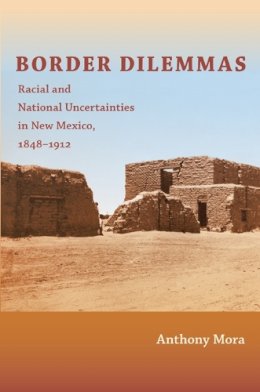
Stock image for illustration purposes only - book cover, edition or condition may vary.
Border Dilemmas: Racial and National Uncertainties in New Mexico, 1848–1912
Anthony P. Mora
€ 50.69
FREE Delivery in Ireland
Description for Border Dilemmas: Racial and National Uncertainties in New Mexico, 1848–1912
Paperback. A historical analysis of the conflicting ideas about race and national belonging held by Mexicans and Euro-Americans in southern New Mexico during the late nineteenth century and early twentieth. Num Pages: 392 pages, 9 illustrations, 1 map. BIC Classification: 1KBBWX; 3JH; 3JJC; HBJK; HBLL; HBLW; HBTB; JFSL. Category: (P) Professional & Vocational. Dimension: 235 x 156 x 25. Weight in Grams: 554.
The U.S.-Mexican War officially ended in 1848 with the signing of the Treaty of Guadalupe Hidalgo, which called for Mexico to surrender more than one-third of its land. The treaty offered Mexicans living in the conquered territory a choice between staying there or returning to Mexico by moving south of the newly drawn borderline. In this fascinating history, Anthony Mora analyzes contrasting responses to the treaty’s provisions. The town of Las Cruces was built north of the border by Mexicans who decided to take their chances in the United States. La Mesilla was established just south of the border by men and women who did not want to live in a country that had waged war against the Mexican republic; nevertheless, it was incorporated into the United States in 1854, when the border was redrawn once again. Mora traces the trajectory of each town from its founding until New Mexico became a U.S. state in 1912. La Mesilla thrived initially, but then fell into decay and was surpassed by Las Cruces as a pro-U.S. regional discourse developed. Border Dilemmas explains how two towns, less than five miles apart, were deeply divided by conflicting ideas about the relations between race and nation, and how these ideas continue to inform discussion about what it means to “be Mexican” in the United States.
Product Details
Format
Paperback
Publication date
2011
Publisher
Duke University Press United States
Number of pages
392
Condition
New
Number of Pages
392
Place of Publication
North Carolina, United States
ISBN
9780822347972
SKU
V9780822347972
Shipping Time
Usually ships in 7 to 11 working days
Ref
99-1
About Anthony P. Mora
Anthony Mora is Assistant Professor of History, American Culture, and Latina/o Studies at the University of Michigan.
Reviews for Border Dilemmas: Racial and National Uncertainties in New Mexico, 1848–1912
“Border Dilemmas occupies a singular place in the literature on the West. It chronicles cultural relations and the generation of difference along the U.S.-Mexican border at the very moment when both American and Mexican national identities were being forged. Until now, no one has documented the nitty-gritty of this process and the ways that ethnic Mexicans on both sides of the border grappled with the production of local identities anchored in competitive national imaginaries.”—Ramón A. Gutiérrez, co-editor of Mexicans in California: Transformations and Challenges “In all, this study makes a sizable contribution to our understanding of the diversity and complexity of borderlands identities…. Mora’s work is a must for anyone interested in borderlands history and the interplay of race and nationalism in colonial frontiers.”
Janne Lahti
Canadian Journal of History
“Mora’s work ... provides a theoretical platform for understanding the issues of changing identity of Mexican Americans outside of New Mexico.”
F. Arturo Rosales
Hispanic American Historical Review
“Although it is thick with detail and information, the book is easy to read and informative. It presents important information, not only for those interested in the history of New Mexico, the Southwest, or even of the United States, but also for anyone interested in multiculturalism, the nature of the modern State and the social construction of race and identity. The book is ideal for the general reader, as well as for use in courses in social history, gender studies, race and ethnicity and international politics.”
Ronald J. Angel
Ethnic and Racial Studies
“Anthony Mora has written a thoughtful extended essay on the racialization of citizenship and the demarcation of distinct communities in the context of the U.S.-Mexico border region.”
Cynthia Radding
American Historical Review
“Besides cutting new trails toward the subject of southern New Mexico and religion along the border, Border Dilemmas offers a sophisticated and clearly written use of cultural theory and a wealth of Spanish-language sources to bolster its central arguments about the retention of Mexican identity and affiliation. The book deserves wide readership among historians of the United States, the American West, and the U.S.-Mexico borderlands.”
Pablo Mitchell
Journal of American History
Janne Lahti
Canadian Journal of History
“Mora’s work ... provides a theoretical platform for understanding the issues of changing identity of Mexican Americans outside of New Mexico.”
F. Arturo Rosales
Hispanic American Historical Review
“Although it is thick with detail and information, the book is easy to read and informative. It presents important information, not only for those interested in the history of New Mexico, the Southwest, or even of the United States, but also for anyone interested in multiculturalism, the nature of the modern State and the social construction of race and identity. The book is ideal for the general reader, as well as for use in courses in social history, gender studies, race and ethnicity and international politics.”
Ronald J. Angel
Ethnic and Racial Studies
“Anthony Mora has written a thoughtful extended essay on the racialization of citizenship and the demarcation of distinct communities in the context of the U.S.-Mexico border region.”
Cynthia Radding
American Historical Review
“Besides cutting new trails toward the subject of southern New Mexico and religion along the border, Border Dilemmas offers a sophisticated and clearly written use of cultural theory and a wealth of Spanish-language sources to bolster its central arguments about the retention of Mexican identity and affiliation. The book deserves wide readership among historians of the United States, the American West, and the U.S.-Mexico borderlands.”
Pablo Mitchell
Journal of American History
